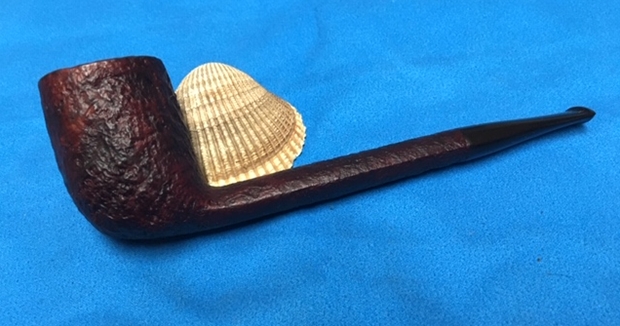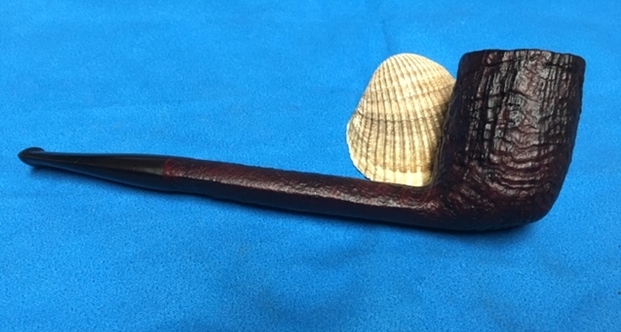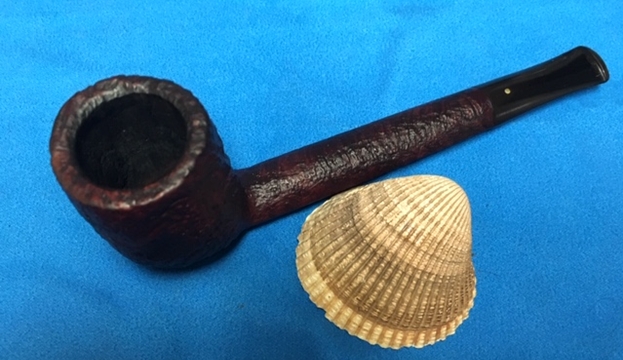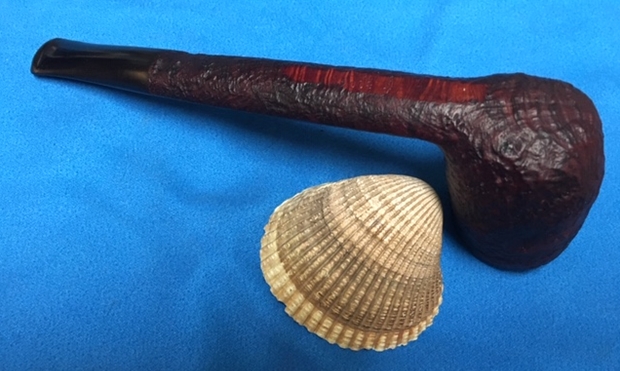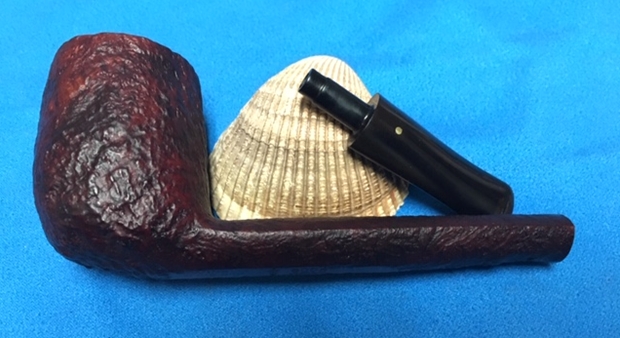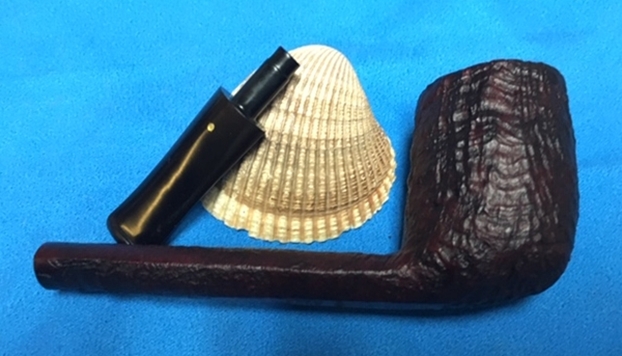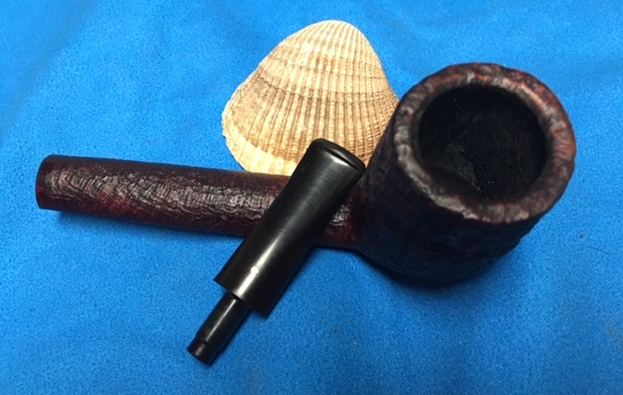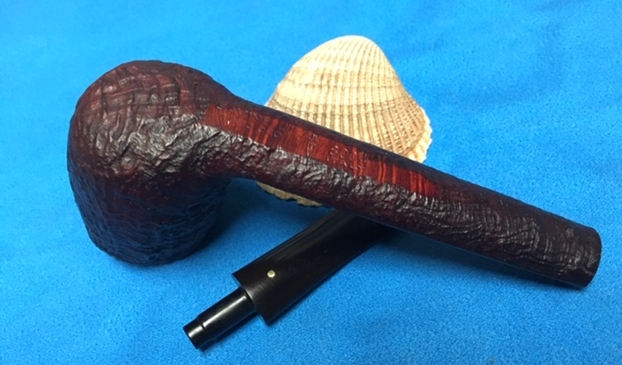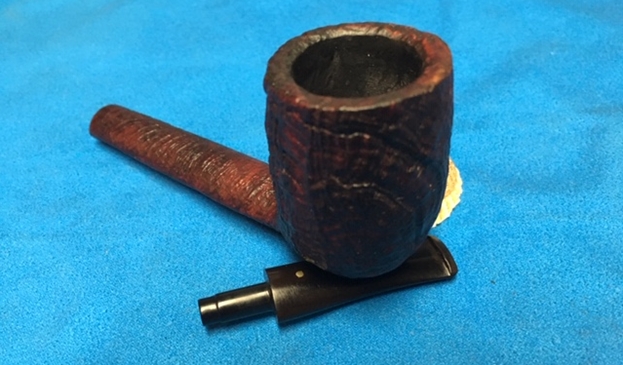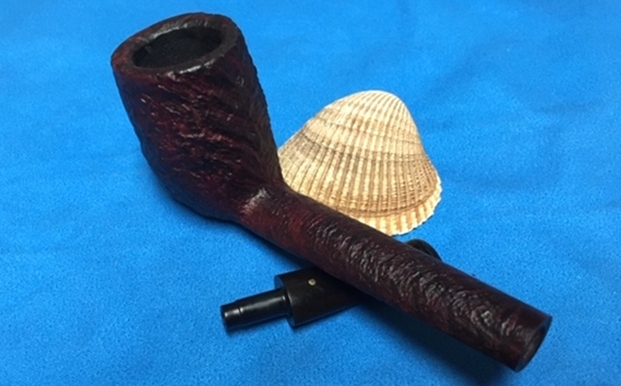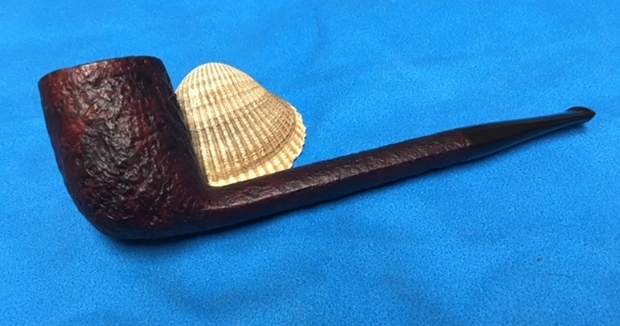Blog by Steve Laug
The next pipe in the queue is yet another interesting pipe from the Michigan lot – a really nice sandblasted Canadian with a deep blast and lots of great grain. The entire pipe – bowl, rim and shank sandblasted with a thin, smooth band at the end of the shank. It is another totally unique pipe and different from any of the other pipes in the collection. It is not a large pipe – probably a Group 4 sized bowl. The rim top has a slight inward bevel on the inner edge of the flat rim top. The pipe has a contrasting black, oxblood and brown stain coats that highlights and accentuates the blast. The underside of the shank has a smooth patch from the heel down most of the shank. It is stamped Savinelli over Punto Oro with a Savinelli S shield followed by the shape number 8004 over Italy. The stem is vulcanite and has a small brass dot on the top near the shank. This is another nice looking piece much like the rest of those in this 21 pipe Michigan pipe lot. The Savinelli I am working on now is on the first shelf of the rack. It is the second pipe on the left and I put a red box around it to make it easy to identify. 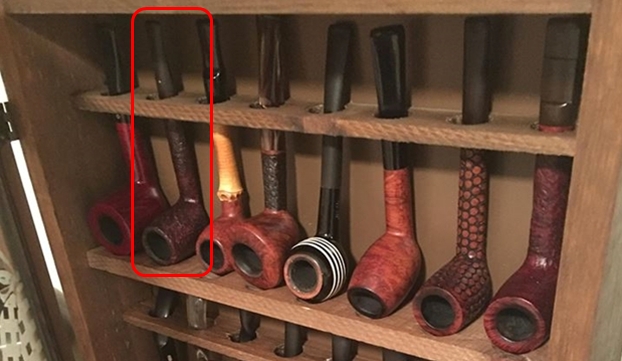 Jeff took some photos of the pipe when he received them to show the general condition of the pipe before he started his cleanup work. Like the rest of the pipes from the Michigan collection this pipe was dirty and well used. There was a thick cake in the bowl and lava overflowing onto the rim top. It was hard to know if the edges of the bowl were damaged or not because of the cake and lava. The deep sandblast on the bowl, shank make the pipe very interesting. The vulcanite stem is lightly oxidized and has some calcification at the button. There are deep tooth marks on both sides of the stem at the button edge and some wear on the button edge itself. There are also scratches in the vulcanite where it looks like someone scraped off some of the calcification. The photos below tell the story and give a glimpse of the beautiful Canadian.
Jeff took some photos of the pipe when he received them to show the general condition of the pipe before he started his cleanup work. Like the rest of the pipes from the Michigan collection this pipe was dirty and well used. There was a thick cake in the bowl and lava overflowing onto the rim top. It was hard to know if the edges of the bowl were damaged or not because of the cake and lava. The deep sandblast on the bowl, shank make the pipe very interesting. The vulcanite stem is lightly oxidized and has some calcification at the button. There are deep tooth marks on both sides of the stem at the button edge and some wear on the button edge itself. There are also scratches in the vulcanite where it looks like someone scraped off some of the calcification. The photos below tell the story and give a glimpse of the beautiful Canadian.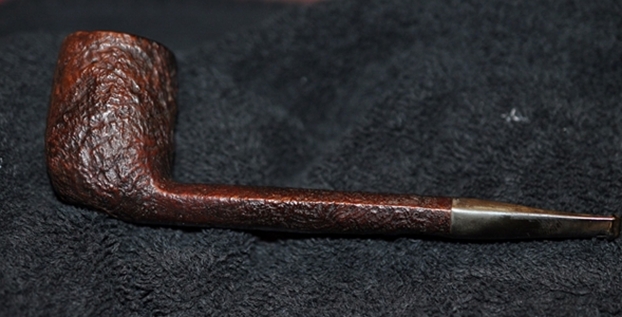
 Jeff took a close up photo of the bowl and rim to capture the condition of the pipe before he started his cleanup work. The rim top had some thick lava overflow and some darkening. The thick lava on the rim top made it hard to know what the inner and outer edges of the bowl looked like. There is also a general accumulation of dust in the finish on the rest of the bowl and shank.
Jeff took a close up photo of the bowl and rim to capture the condition of the pipe before he started his cleanup work. The rim top had some thick lava overflow and some darkening. The thick lava on the rim top made it hard to know what the inner and outer edges of the bowl looked like. There is also a general accumulation of dust in the finish on the rest of the bowl and shank. He also took photo of the right and underside of the bowl and shank to show the interesting sandblast finish. The finish is very dirty but this is another beautiful pipe.
He also took photo of the right and underside of the bowl and shank to show the interesting sandblast finish. The finish is very dirty but this is another beautiful pipe.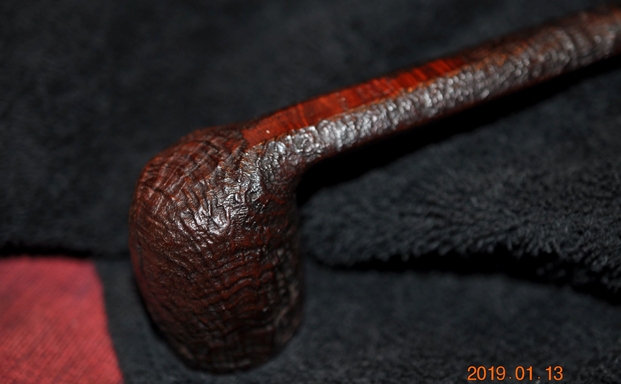 Jeff took a photo to capture the stamping on the underside of the shank. The photo shows stamping as noted above. The stamping on this pipe is clear and readable.
Jeff took a photo to capture the stamping on the underside of the shank. The photo shows stamping as noted above. The stamping on this pipe is clear and readable. The next two photos show the stem surface. They show the tooth marks and chatter on both sides near the button. There are also some marks on the sharp edge of the button. The stem is dirty, oxidized and has a yellow cast to it. The single brass Punto dot on the top of the stem is almost invisible.
The next two photos show the stem surface. They show the tooth marks and chatter on both sides near the button. There are also some marks on the sharp edge of the button. The stem is dirty, oxidized and has a yellow cast to it. The single brass Punto dot on the top of the stem is almost invisible.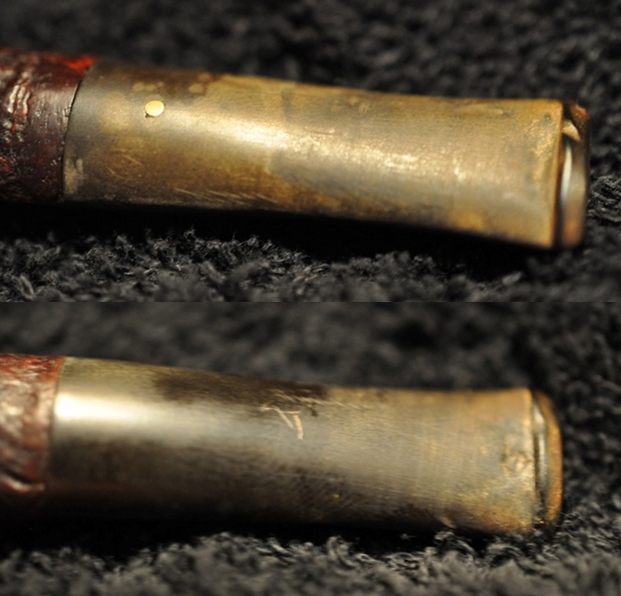 Jeff reamed the bowl with a PipNet pipe reamer and followed up with a Savinelli Fitsall pipe knife to remove the cake. He scrubbed out the mortise and the airway in the shank and the stem with alcohol, cotton swabs and pipe cleaners. He scrubbed the exterior of the bowl, rim, shank and stem with a tooth brush and Murphy’s Oil Soap to remove the oils and tars on the rim and the grime on the finish of the bowl. He rinsed it under running water. He dried it off with a soft cloth. He was able to remove the lava build up on the rim top and you could see the great condition of the bowl top and edges of the rim. He soaked the stem in Before & After Deoxidizer to remove the oxidation. I took photos of the pipe to show its condition before I started my work on it.
Jeff reamed the bowl with a PipNet pipe reamer and followed up with a Savinelli Fitsall pipe knife to remove the cake. He scrubbed out the mortise and the airway in the shank and the stem with alcohol, cotton swabs and pipe cleaners. He scrubbed the exterior of the bowl, rim, shank and stem with a tooth brush and Murphy’s Oil Soap to remove the oils and tars on the rim and the grime on the finish of the bowl. He rinsed it under running water. He dried it off with a soft cloth. He was able to remove the lava build up on the rim top and you could see the great condition of the bowl top and edges of the rim. He soaked the stem in Before & After Deoxidizer to remove the oxidation. I took photos of the pipe to show its condition before I started my work on it.
 I took a close up photo of the rim top to show the darkening on the surface of the rim toward the back of the bowl that was normal with use. The front part of the rim top looked a little lighter in colour but the sandblast on the entire rim made the rim top repairs minimal. The inner edge and the outer edge of the rim look really good. The stem photos show the tooth marks and the wear on the button surface on both sides. The final close up photos shows the Savinelli stamping on the underside of the shank.
I took a close up photo of the rim top to show the darkening on the surface of the rim toward the back of the bowl that was normal with use. The front part of the rim top looked a little lighter in colour but the sandblast on the entire rim made the rim top repairs minimal. The inner edge and the outer edge of the rim look really good. The stem photos show the tooth marks and the wear on the button surface on both sides. The final close up photos shows the Savinelli stamping on the underside of the shank.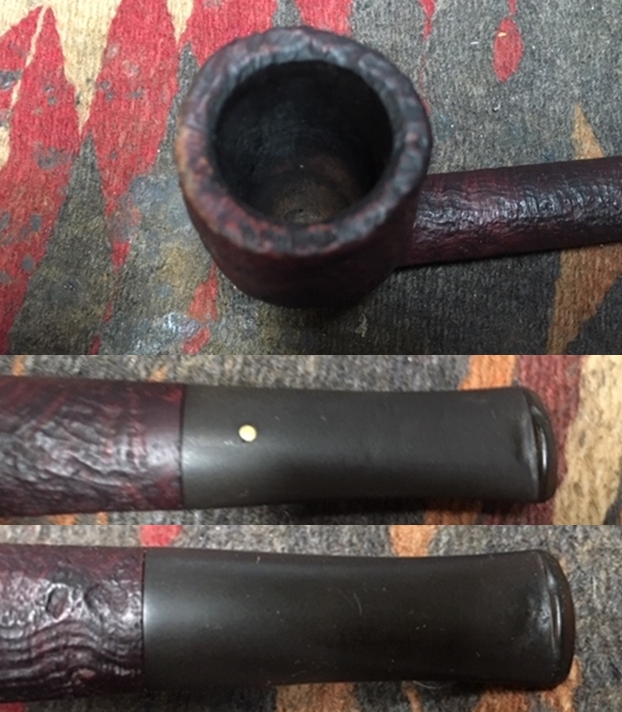
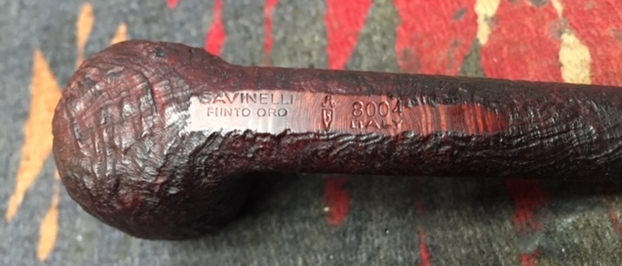 Jeff had done such a great job cleaning the surface of the pipe that there was nothing I needed to do move forward. I started by working some Before & After Restoration Balm into the sand blast finish of the briar with my fingertips to clean, enliven and protect it. I let the balm sit for a little while and then buffed with a cotton cloth to raise the shine. The following photos show the bowl at this point in the restoration process. The bowl and the rim top look really good and the darkening and lava are gone. The finish looks very good and I am very happy with the results.
Jeff had done such a great job cleaning the surface of the pipe that there was nothing I needed to do move forward. I started by working some Before & After Restoration Balm into the sand blast finish of the briar with my fingertips to clean, enliven and protect it. I let the balm sit for a little while and then buffed with a cotton cloth to raise the shine. The following photos show the bowl at this point in the restoration process. The bowl and the rim top look really good and the darkening and lava are gone. The finish looks very good and I am very happy with the results.
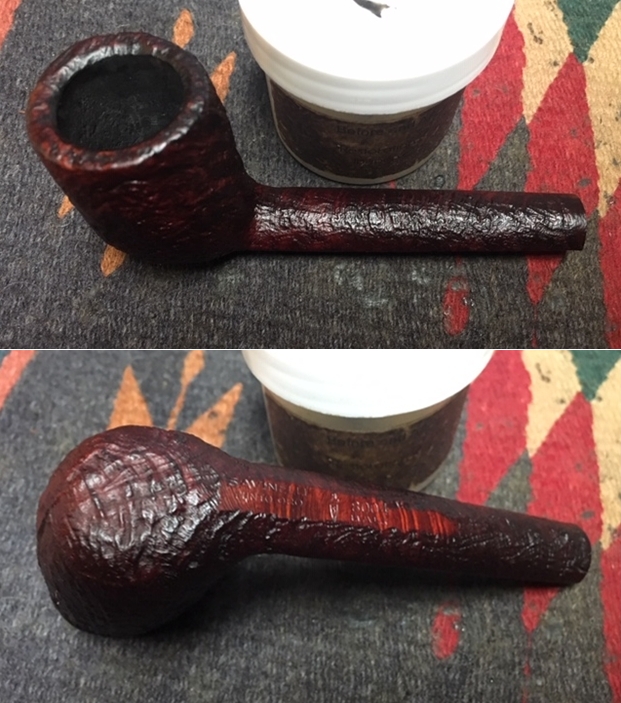
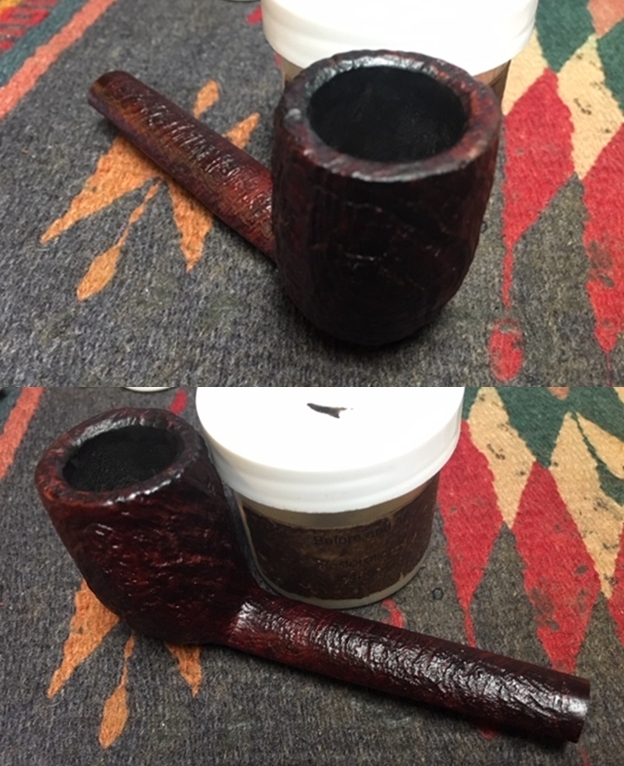 With the bowl finished I set it aside and turned my attention to the stem. I cleaned out the tooth marks on both sides of the stem with a cotton swab and alcohol. I filled in the tooth marks with clear super glue. Once the repairs had cured I used a needle file to flatten out the repaired areas. I filed it until the patches were smooth with the surface of the stem.
With the bowl finished I set it aside and turned my attention to the stem. I cleaned out the tooth marks on both sides of the stem with a cotton swab and alcohol. I filled in the tooth marks with clear super glue. Once the repairs had cured I used a needle file to flatten out the repaired areas. I filed it until the patches were smooth with the surface of the stem.
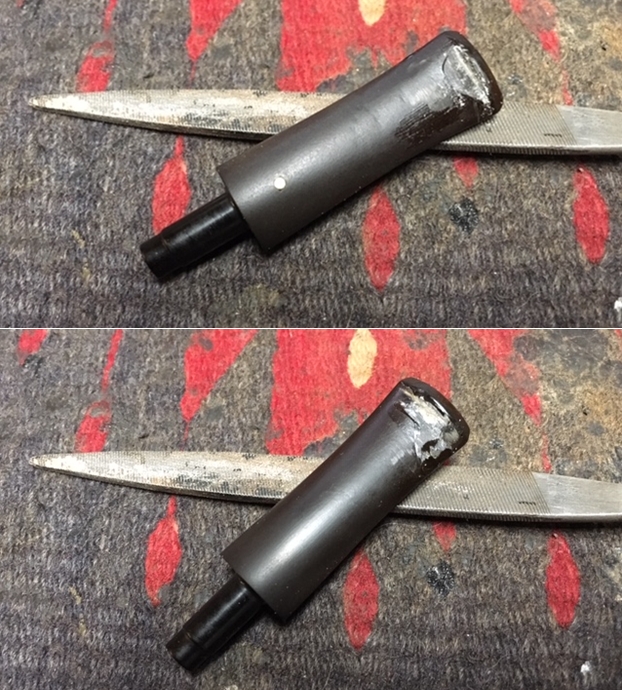 I used a folded piece of 240 grit sandpaper to blend the repairs into the surface of the stem. Once the surface was smooth I sanded out the scratch marks and started the polishing of the stem with a folded piece of 400 grit sandpaper. I wiped the stem down with a damp cloth and took the following photos.
I used a folded piece of 240 grit sandpaper to blend the repairs into the surface of the stem. Once the surface was smooth I sanded out the scratch marks and started the polishing of the stem with a folded piece of 400 grit sandpaper. I wiped the stem down with a damp cloth and took the following photos. I polished the stem with micromesh sanding pads – wetsanding it with 1500-2400 grit pads and dry sanding it with 3200-12000 grit pads. I wiped the stem down with a damp cloth after each pad. I further polished it with Before & After Pipe Polish – both Fine and Extra Fine. I wiped it down with a coat of Obsidian Oil and set it aside to dry.
I polished the stem with micromesh sanding pads – wetsanding it with 1500-2400 grit pads and dry sanding it with 3200-12000 grit pads. I wiped the stem down with a damp cloth after each pad. I further polished it with Before & After Pipe Polish – both Fine and Extra Fine. I wiped it down with a coat of Obsidian Oil and set it aside to dry.
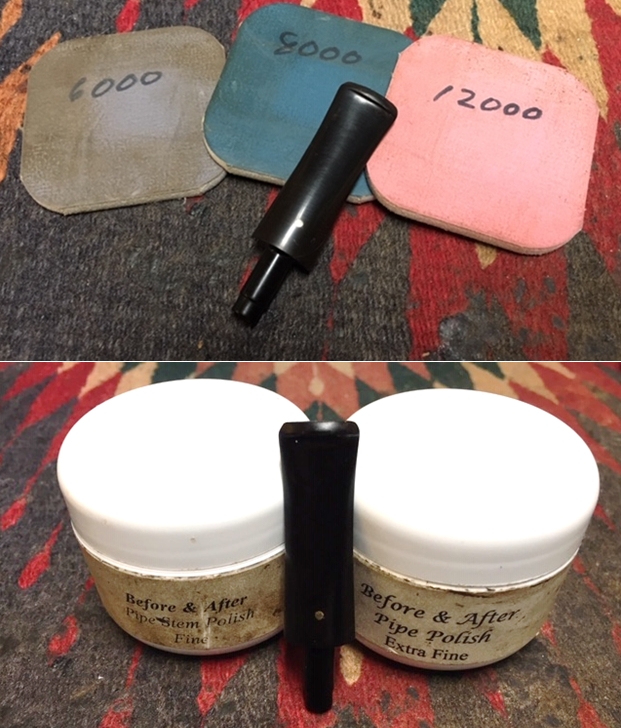 I put the stem back on the bowl so I could polish it without rounding the edges as the shank union. I polished stem with Blue Diamond polish on the buffing wheel. I gave the bowl multiple coats of Conservator’s Wax and the stem multiple coats of carnauba wax. I buffed the pipe with a clean buffing pad to raise the shine. I hand buffed it with a microfiber cloth to deepen the shine. The pipe polished up pretty nicely. The contrasting deep sandblast showed the contrasts between the valleys and the high spots. It truly came alive with the buffing. The rich browns and oxblood stains worked very well with the polished black vulcanite stem. The finished pipe is a beauty and feels great in the hand. Have a look at it with the photos below. The dimensions are Length: 6 inches, Height: 2 inches, Outside diameter of the bowl: 1 1/4 inches, Chamber diameter: 3/4 of an inch. This beauty will be on the rebornpipes store sometime in the days ahead. It may well be the kind of sandblasted Canadian you have been looking for. Let me know if you are interested. Thanks for walking through the restoration of this beautiful Canadian with me it was a pleasure to work on.
I put the stem back on the bowl so I could polish it without rounding the edges as the shank union. I polished stem with Blue Diamond polish on the buffing wheel. I gave the bowl multiple coats of Conservator’s Wax and the stem multiple coats of carnauba wax. I buffed the pipe with a clean buffing pad to raise the shine. I hand buffed it with a microfiber cloth to deepen the shine. The pipe polished up pretty nicely. The contrasting deep sandblast showed the contrasts between the valleys and the high spots. It truly came alive with the buffing. The rich browns and oxblood stains worked very well with the polished black vulcanite stem. The finished pipe is a beauty and feels great in the hand. Have a look at it with the photos below. The dimensions are Length: 6 inches, Height: 2 inches, Outside diameter of the bowl: 1 1/4 inches, Chamber diameter: 3/4 of an inch. This beauty will be on the rebornpipes store sometime in the days ahead. It may well be the kind of sandblasted Canadian you have been looking for. Let me know if you are interested. Thanks for walking through the restoration of this beautiful Canadian with me it was a pleasure to work on.